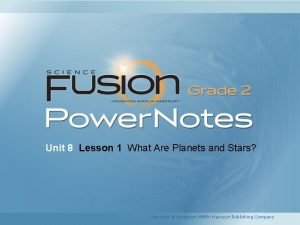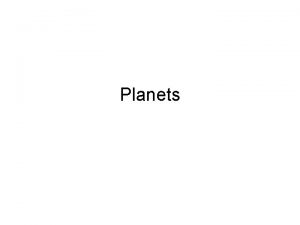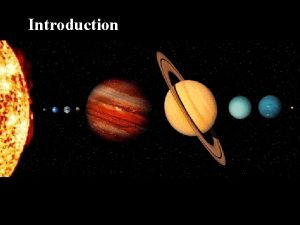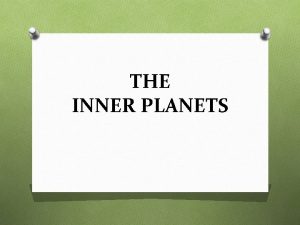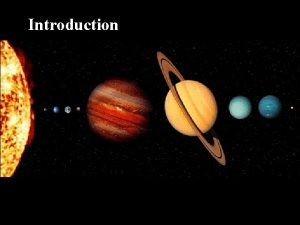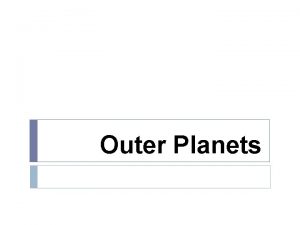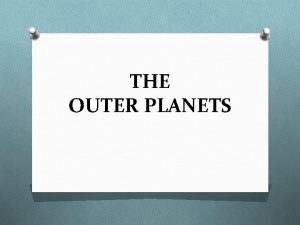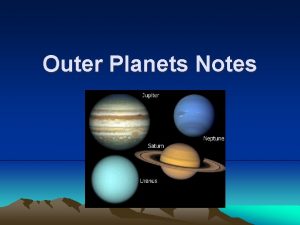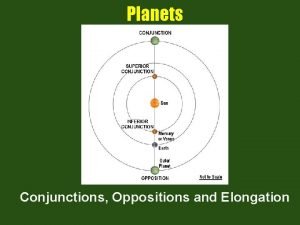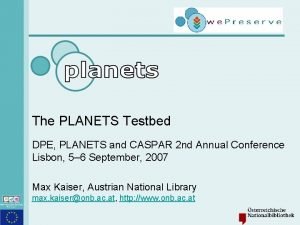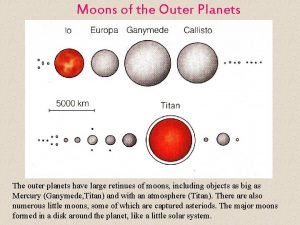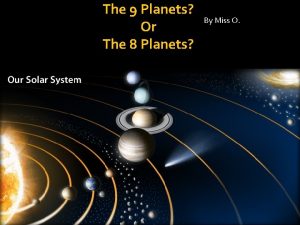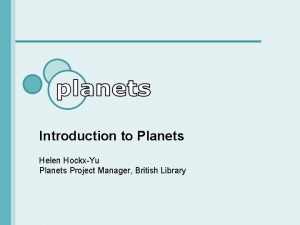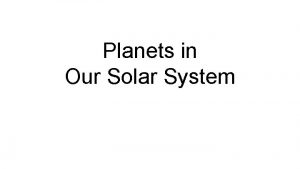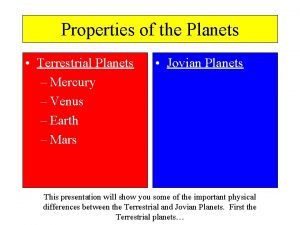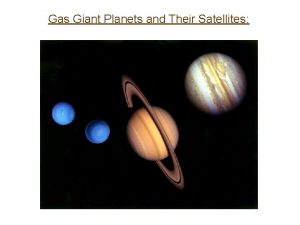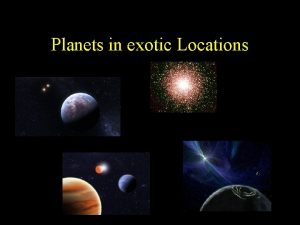Lesson 3 The Planets Lesson 3 The Planets
















































- Slides: 48

Lesson 3 The Planets

Lesson 3: The Planets Standard S 6 E 1. c Compare and contrast the planets in terms of: size relative to the Earth, surface & atmospheric features, relative distance from the sun, and ability to support life.

Warm Up: Can you list the planets in order from the sun?

What are some things you can compare and contrast about the planets?

Label the planets on your paper.

Label the inner (aka. terrestrial planets) and outer planets (aka gas giants).

Write one of these analogies at the bottom of your solar system sheet: My very educated mother just said uh-oh no pluto. My Very Eager Mother just served us nine pies.

Animation: Distance of Planets from the Sun & Each Other http: //www. classzone. com/books/earth_science/terc /content/visualizations/es 2701 page 01. cfm? chapter_no=visualization (Zoom animation to 300) Run in Place while we travel…. At the speed of today's fastest spacecraft (~20 km/second), it would take almost ten years to travel this distance. Even at the speed of light, the trip would last 5 1/2 hours. In this animation, the apparent speed of the viewer is over 300 times the speed of light.

Animation: Distance of Planets from the Sun & Each Other http: //glencoe. mcgrawhill. com/olcweb/cgi/pluginpop. cgi? it=d cr: : 592: : 370: : /sites/dl/free/0078778441/ 165519/523. dcr: : Drag and Drop Puzzle Drag-drop game for inner and outer planets….

Terms: The Planets Study Jams Inner Planets http: //studyjams. scholastic. com/studyjams/s cience/solar-system-inner. htm

1. What factors exists on Earth that make life possible here, but unlikely on any other planet? Earth has Liquid water, moderate temperature, and an atmosphere rich in oxygen, which are all needed for life.

2. Which planets in the solar system are called the “gas giants” and why? Jupiter, Saturn, Uranus, Neptune. They are giant planets, much larger than Earth. They are mainly composed of gases and do not have well-defined surfaces.

3. In general, what condition on the planets is MOST affected by its distance from the sun? temperature. It will get colder further from the sun and hotter closer to it.



The Inner Planets Also known as the “Terrestrial Planets” • Mercury • Venus • Earth • Mars

Mercury- 0 Moons Planet Surface Features Mercury rocky surface with many craters Atmospheric Conditions very thin atmosphere Distance from the sun 58, 000 km Diameter 4, 880 km Year Length (Earth Years) 88 days Gravity (X Earth’s 0 0. 38 Moons 0

Mercury Planet Rings Cool facts ? Mercury no closest to the sun high temperature Distance from the sun 58, 000 km Diameter 4, 880 km Year Length (Earth Years) 88 days Gravity (X Earth’s 0 0. 38 Moons 0

Venus- 0 Moons Planet Surface Features Venus rocky surface Atmospheric Conditions atmosphere thick with carbon dioxide, which traps heat under it. Distance from the Sun 108, 000 km Diameter 12, 100 km Year Length (Earth Years) 225 days Gravity (X Earth’s) 0. 91 Moons 0

Venus Planet Venus Rings? no Distance from the Sun 108, 000 km Diameter 12, 100 km Year Length (Earth Years) 225 days Gravity (X Earth’s) 0. 91 Moons 0 Cool facts Close to the same size as Earth Hotter than Mercury because of the Carbon Dioxide in the atmosphere

Earth (1 moon) Planet Surface Features Earth Atmospheric Conditions Rocky surface is covered 78% nitrogen with plains, 21% oxygen valleys, mountains, plateaus, active volcanoes. About ¾ of surface is covered with water. Distance from the Sun 150, 000 km Diameter = 12, 760 km Length of Year = 365. 25 days Gravity = 1 Moons = 1

Earth (1 moon) Distance from the Sun 150, 000 km Diameter = 12, 760 km Length of Year = 365. 25 days Planet Rings? Earth no Cool facts Only planet that can support life because it has liquid water, moderate temperatures, & an oxygen rich atmosphere. Gravity = 1 Moons = 1

Mars Planet Surface Features Mars rocky and dusty surface, hills, plains, mountains, extinct volcanoes, craters, Atmospheric Conditions Thin atmosphere of carbon dioxide Distance from the Sun 228, 000 km Diameter 6, 790 km Year Length (Earth Years) 687 days Gravity (X Earth’s) 0. 38 Moons 2

Mars (2 moons) Planet Mars Rings Cool facts ? no Known as the Red Planet due to iron making “dirt” red Ice caps in the north and south poles Largest volcano in the solar system May have once had water May have once supported life Distance from the Sun 228, 000 km Diameter 6, 790 km Year Length (Earth Years) 687 days Gravity (X Earth’s) 0. 38 Moons 2


The Outer Planets “Gas Giants” • Jupiter • Saturn • Uranus • Neptune *No solid surfaces to walk upon*

• outer planets : The planets that are much farther from the sun: – Jupiter, Saturn, Uranus, Neptune – Outer planets are larger and composed of gas…. Gas giants • Pluto is a dwarf planet – it is not included in the outer planets group because it has different characteristics

Jupiter (63 moons) Planet Surface Features Jupiter No solid surface Atmospheric Conditions slushy ball of liquid hydrogen, • atmosphere mostly helium and hydrogen gases. • large red spot (gigantic storm or hurricane). Distance from the Sun 778, 000 km Diameter 143, 000 km Yea Length (Earth Years) 119 years Gravity (X Earth’s) 2. 53 Moons 63

Saturn (47 moons) Planet Surface Features Saturn No solid surface Atmospheric Conditions Hydrogen & helium gases Distance from the Sum 1, 427, 000 km Diameter 120, 500 km Year Length (Earth Years) 29. 4 years Gravity (X Earth’s) 1. 14 Moons 47

Saturn In 1979 the Voyager 1 spacecraft saw that Jupiter has rings like Saturn too, albeit a much fainter system primarily made up of dust. The particles in Jupiter's ring are smaller than those in Saturn's rings and do not reflect light as well. In the case of Jupiter, physical models suggest that the particles should not be able to remain in the rings very long, thus the rings should dissolve over time.

Uranus (27 moons) Planet Uranus Distance from the Sun 2, 871, 000 km Diameter 51, 100 km Year Length (Earth Years) 84 years Gravity (X Earth’s) 0. 9 Moons 27 Surface Atmospheric Features Conditions No solid • surface completely covered with water, methane, and ammonia

Neptune Planet Surface Features Neptune No solid surface; Distance from the Sun 4, 498, 000 km Diameter 49, 500 km Year Length (Earth Years) 165 years Gravity (X Earth’s) 1. 14 Moons 13 Atmospheric Conditions • methane gas clouds icy ocean of water, methane, ammonia, hydrogen

RINGS & COOL FACTS

Jupiter (63 moons) Planet Rings ? Jupiter Yes, thin ones Cool facts Largest planet Giant red spot (largest hurricane in solar system) Distance from the Sun 778, 000 km Diameter 143, 000 km Yea Length (Earth Years) 119 years Gravity (X Earth’s) 2. 53 Moons 63

Jupiter (63 moons)

Jupiter: Great Red Spot (hurricane/storm)

Jupiter: Great Red Spot (hurricane/storm)

Saturn (47 moons) Distance from the Sum 1, 427, 000 km Diameter 120, 500 km Year Length (Earth Years) 29. 4 years Gravity (X Earth’s) Moons Planet Rings? Cool facts Saturn Yes, Complex ring complex system ring 2 nd largest system planet Planet 1. 14 Comparison- Rings & Cool Facts 47

Saturn (47 moons)

Uranus (27 moons) Planet Rings Cool facts ? Uranus Yes, Blue-green color 11 from poisonous rings methane • rotates on its side • poles point toward and away from sun • extremely cold temperature, Distance from the Sun 2, 871, 000 km Diameter 51, 100 km Year Length (Earth Years) 84 years Gravity (X Earth’s) 0. 9 Moons 27

Uranus (27 moons)

Neptune Planet Rings Cool facts ? Neptu Yes, 6 • fourth largest ne rings planet, • glows blue-green b/c of methane gas clouds, Distance from the Sun 4, 498, 000 km Diameter 49, 500 km Year Length (Earth Years) 165 years Gravity (X Earth’s) 1. 14 Moons 13

Quick Check Which planets in the solar system are called the gas giants? a. b. c. d. Mercury, Venus, Earth, Mars Saturn, Uranus, Neptune, Pluto Jupiter, Saturn, Uranus, Neptune Earth, Venus, Pluto, Mars

Quick Check Which is the current and correct model of our solar system? a. b. c. d. The Big Bang Theory The Geocentric Theory The Pythagorean Theory The Heliocentric Theory

Quick Check What three factors exist on Earth that make life possible here, but unlikely on any other planet? A. liquid water, moderate temperatures, atmospheric oxygen B. liquid water, moderate temperatures, atmospheric nitrogen C. liquid water, moderate size of Earth, atmospheric oxygen D. solid water, moderate temperatures, atmospheric oxygen

Quick Check Which planet is MOST LIKELY to support life as we know it? A. Mercury B. Venus C. Jupiter D. Mars

Quick Check In general, what condition is MOST affected by its distance from the sun? A. size B. temperature C. atmosphere D. surface composition

Quick Check The force of gravity on a planet determines the weight of objects on the planet. If you weighted 30 kg (66 pounds) on Earth, what would you weigh on Jupiter? A. 11. 4 kg (5. 2 pounds) B. 30 kg (66 pounds) C. 34. 2 kg (75. 4 pounds) D. 75. 9 kg (167. 3 pounds)
 9 planets
9 planets What separates the inner planets and outer planets
What separates the inner planets and outer planets What is each planet made of
What is each planet made of Inner planets and outer planets
Inner planets and outer planets What are jovian planets made of
What are jovian planets made of Holst the planets lesson plan
Holst the planets lesson plan Planets. lesson 1
Planets. lesson 1 Planets. lesson 1
Planets. lesson 1 Hát kết hợp bộ gõ cơ thể
Hát kết hợp bộ gõ cơ thể Ng-html
Ng-html Bổ thể
Bổ thể Tỉ lệ cơ thể trẻ em
Tỉ lệ cơ thể trẻ em Gấu đi như thế nào
Gấu đi như thế nào Chụp phim tư thế worms-breton
Chụp phim tư thế worms-breton Hát lên người ơi
Hát lên người ơi Các môn thể thao bắt đầu bằng tiếng đua
Các môn thể thao bắt đầu bằng tiếng đua Thế nào là hệ số cao nhất
Thế nào là hệ số cao nhất Các châu lục và đại dương trên thế giới
Các châu lục và đại dương trên thế giới Công của trọng lực
Công của trọng lực Trời xanh đây là của chúng ta thể thơ
Trời xanh đây là của chúng ta thể thơ Cách giải mật thư tọa độ
Cách giải mật thư tọa độ Làm thế nào để 102-1=99
Làm thế nào để 102-1=99 Phản ứng thế ankan
Phản ứng thế ankan Các châu lục và đại dương trên thế giới
Các châu lục và đại dương trên thế giới Thơ thất ngôn tứ tuyệt đường luật
Thơ thất ngôn tứ tuyệt đường luật Quá trình desamine hóa có thể tạo ra
Quá trình desamine hóa có thể tạo ra Một số thể thơ truyền thống
Một số thể thơ truyền thống Cái miệng nó xinh thế
Cái miệng nó xinh thế Vẽ hình chiếu vuông góc của vật thể sau
Vẽ hình chiếu vuông góc của vật thể sau Biện pháp chống mỏi cơ
Biện pháp chống mỏi cơ đặc điểm cơ thể của người tối cổ
đặc điểm cơ thể của người tối cổ V cc
V cc Vẽ hình chiếu đứng bằng cạnh của vật thể
Vẽ hình chiếu đứng bằng cạnh của vật thể Vẽ hình chiếu vuông góc của vật thể sau
Vẽ hình chiếu vuông góc của vật thể sau Thẻ vin
Thẻ vin đại từ thay thế
đại từ thay thế điện thế nghỉ
điện thế nghỉ Tư thế ngồi viết
Tư thế ngồi viết Diễn thế sinh thái là
Diễn thế sinh thái là Dot
Dot Các số nguyên tố là gì
Các số nguyên tố là gì Tư thế ngồi viết
Tư thế ngồi viết Lời thề hippocrates
Lời thề hippocrates Thiếu nhi thế giới liên hoan
Thiếu nhi thế giới liên hoan ưu thế lai là gì
ưu thế lai là gì Khi nào hổ con có thể sống độc lập
Khi nào hổ con có thể sống độc lập Sự nuôi và dạy con của hổ
Sự nuôi và dạy con của hổ Hệ hô hấp
Hệ hô hấp Từ ngữ thể hiện lòng nhân hậu
Từ ngữ thể hiện lòng nhân hậu






